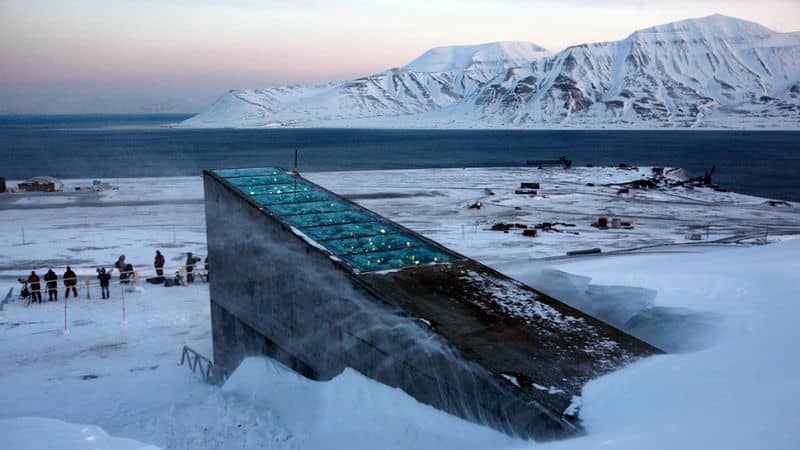
With seed banks, scientists and plant breeders can continue to use the material to engineer crops with qualities that make them more resilient. Each farm now produces one crop, one very specialized product.”Ĭrop Trust, which partnered with the Norwegian government to build the vault a decade ago, says it can safeguard the food supply. It very quickly went from a diverse, self-sufficient farming system to an industrial way of producing food. This is actually the story of agriculture. “Suddenly in 1975,” he says, “all the fields were covered with grass, feed for the animals, and the only animals left on the farm were cows producing milk. If one kind of wheat succumbed to an infestation or a lack of water, a slightly different neighbor might thrive.Īs we drive back from the vault to town, Asdal describes growing up on the family farm in southern Norway-and the dramatic shift to modern farming. They relied on an assortment of varieties. “People diversify their financial portfolios, so why aren't we diversifying our agriculture system?” “When you have monocultures or plant a very narrow range of varieties, they're very susceptible to pests and diseases and can easily be quite vulnerable to different climate change threats,” says Tutwiler. ( See how the seed vault was opened because of war in Syria.) Diversifying Our Food Today, only three varieties make up 82 percent of the island’s farmed area. (Read about the threat to bananas.) Climate change means one drought could wipe out a non-resilient strain.Īs an example, farmers used to grow 1,700 different kinds of rice in Taiwan, says Ann Tutwiler, director of Bioversity International, a conservation organization focusing on biodiversity. Industrial agriculture relies on monocrops of clones, so one pest could potentially wipe out an entire susceptible variety. Those staples include around 140,000 different samples of wheat varieties 150,000 samples of rice 70,000 samples of barley and between 10,000 and 20,000 samples each of different kinds of potatoes, peas, sorghum, and many other crops.Īside from an apocalypse-nuclear war, asteroids-there are multiple threats facing farming today. “We keep plants here that are important for the production of food,” Asdal says. It does not store the seeds of endangered plants it protects the genetic material of the foods we see on our plates every day, as well as the wild relatives of these plants. The vault was founded as a safety net for national seed banks, which donated the samples. The vault is said to be an ideal location for long-term storage, partly because permafrost offers cost-effective freezing–and it would take a long time to thaw in case of a power outage. They’re stored behind heavy doors covered in a layer of glittering ice, in three big rooms deep inside the mountain. An Ark for FoodĬurrently, the facility holds around 930,000 seed samples representing 5,000 plant species. As the globe warms, this small ditch is not enough to protect the warehouse from surface runoff. This has meant warming temperatures, avalanches, rain and, most damaging for the seed vault, melting permafrost. In a cruelly ironic twist for what is meant to be a doomsday backup for civilization, climate change is working faster here than in many other places around the world. Svalbard was thought to be the perfect place to preserve and store seeds because it is a polar desert-cold and dry, with little snow and not much rain. Twenty years ago, this trench might have been sufficient. “I think that's quite a good comparison.” But now, on its tenth anniversary, the initiative is confronting one of the very forces it is meant to protect against: global warming.Ī small drainage ditch in front of the entrance diverts rainwater streaming down the cold rock of the mountain. “People call the vault a Noah’s Ark for seeds,” says Asdal, a biologist and agronomist. The storage vault-in Norway’s Svalbard archipelago 800 miles above the Arctic Circle-was designed to ensure that nature’s vast array of genes is not lost.Īt the entrance tunnel to the warehouse, the wind is drowned out by the roar of a cooling system that deepens the freeze in the space to minus 18☌ (0☏)-a temperature ensuring that seed samples stay viable in the event of a global cataclysm. Today the wide range of plants that humans have relied on throughout history is threatened by the clones of modern industrial agriculture, new diseases, and climate change. “The main reason we have civilization is that humans developed ways of using seeds,” says Asdal, the operations and management coordinator of the facility, as he peers over the steering wheel through the haze.

Longyearbyen, SvalbardThe windshield wipers on the SUV work overtime as Åsmund Asdal zigzags up the fog-covered mountain to the Svalbard Global Seed Vault.


 0 kommentar(er)
0 kommentar(er)
